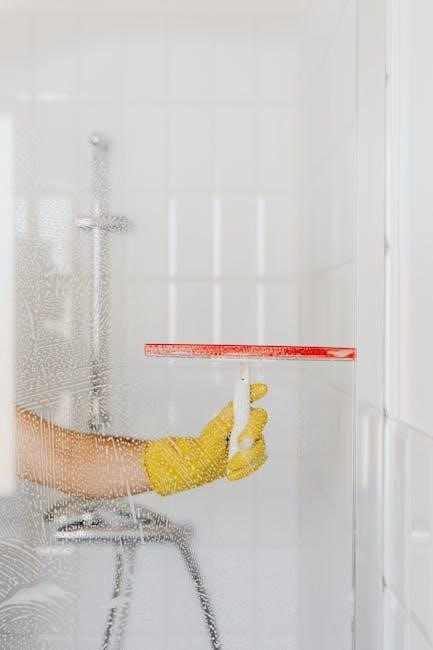A manual scaler is a handheld dental instrument used by dentists and hygienists to remove plaque, tartar, and stains from teeth, ensuring precise control and effective cleaning during routine dental procedures.
1.1 Overview of Manual Scalers
Manual scalers are handheld dental instruments designed for precise removal of plaque, tartar, and stains from teeth. They are typically made of high-quality materials, ensuring durability and effectiveness. Available in straight or curved designs, they cater to different dental needs. Single-use options minimize infection risks, while reusable scalers prioritize cost-efficiency. Unlike ultrasonic scalers, manual tools offer better control for sensitive teeth or areas with enamel loss. Widely used in dental practices, they are essential for maintaining oral hygiene and preventing periodontal diseases. Their simplicity and effectiveness make them a cornerstone in routine dental cleanings.
1.2 History and Evolution of Manual Scalers
The manual scaler has a long history, with early versions dating back to ancient civilizations using twigs or bone tools for oral cleaning. In the Middle Ages, primitive metal instruments were developed for plaque removal. By the 18th and 19th centuries, more refined designs emerged, incorporating curved and angled blades. The 20th century saw the introduction of stainless steel, improving durability. Modern manual scalers now feature ergonomic handles and precise angles, with options for single-use and reusable models. This evolution reflects advancements in materials and techniques, ensuring better comfort and effectiveness in dental care.
Types of Manual Scalers
Manual scalers come in various forms, including straight, curved, and single-use or reusable options, each designed for specific dental procedures and patient needs.
2.1 Straight Manual Scalers
Straight manual scalers are versatile instruments designed for removing plaque and tartar from specific areas of the teeth. Their straight design allows for precise access to anterior teeth and interdental spaces, making them ideal for subgingival scaling. These scalers are often preferred for their simplicity and effectiveness in reaching tight spaces. They are commonly used in routine cleanings and are known for their durability and ease of use. Straight manual scalers are a fundamental tool in dental hygiene, offering precise control and versatility for various dental procedures.
2.2 Curved Manual Scalers
Curved manual scalers are designed with angled or curved blades, enabling better access to posterior teeth and larger surfaces. Their unique shape allows for efficient removal of plaque and tartar from hard-to-reach areas, making them ideal for subgingival scaling. These scalers are particularly effective for patients with specific anatomical challenges or severe tartar buildup. Their curved design provides improved leverage and precision, ensuring thorough cleaning while minimizing discomfort for the patient. Curved manual scalers are a valuable addition to dental hygiene practices, offering versatility and effectiveness in various clinical scenarios.
2.3 Single-Use vs. Reusable Manual Scalers
Single-use manual scalers are disposable instruments designed for one-time use, reducing the risk of cross-contamination and infection. They are ideal for practices prioritizing hygiene and convenience. Reusable manual scalers, while more cost-effective, require proper sterilization to ensure safety. Single-use options are lightweight and pre-sterilized, offering convenience, especially in high-volume clinics. Reusable scalers, however, are durable and environmentally friendly, making them a popular choice for budget-conscious practices. Both types are effective for plaque and tartar removal, but the choice depends on clinical preferences, patient volume, and infection control protocols. Each has its advantages, catering to different dental practice needs.

Benefits of Manual Scalers
Manual scalers offer precision, control, and effectiveness in removing plaque and tartar. They are cost-effective, durable, and suitable for sensitive teeth, making them a valuable tool in dental care.
3.1 Advantages Over Ultrasonic Scalers
Manual scalers provide precise control and tactile sensitivity, making them ideal for delicate cases. They do not generate heat, reducing discomfort for sensitive patients. Unlike ultrasonic scalers, manual tools are quiet and vibration-free, offering a more comfortable experience. They are also cost-effective, requiring no electricity or maintenance, and are easily sterilized. Manual scalers are preferred for patients with sensitive teeth or thin enamel, as they minimize the risk of damage. Their simplicity and reliability make them a valuable option in dental care, especially for routine cleanings and specific clinical scenarios where ultrasonic scalers may be less suitable.
3.2 Effectiveness in Plaque and Tartar Removal
Manual scalers are highly effective in removing plaque and tartar, especially in deep pockets and sensitive areas. Their precise design allows for targeted removal of calculus without causing damage to the tooth or gum. Unlike ultrasonic scalers, manual tools do not generate heat, making them safer for sensitive teeth. They are particularly effective in cases where precision and control are crucial, such as in periodontal maintenance or delicate dental anatomy. Regular use of manual scalers helps prevent gum disease and promotes long-term oral health, making them a reliable choice for both dentists and patients.
3.3 Cost-Effectiveness and Durability
Manual scalers are a cost-effective option for dental practices, offering long-term durability when properly maintained. Unlike ultrasonic scalers, they do not require expensive replacement parts or frequent servicing, making them a budget-friendly choice. Reusable manual scalers are particularly economical, as they can withstand repeated sterilization and use. Their simplicity in design ensures they remain functional for years, reducing the need for frequent replacements. Additionally, single-use manual scalers provide a hygienic and affordable solution for practices with high patient volumes, further enhancing their cost-effectiveness. This combination of durability and affordability makes manual scalers a preferred tool for many dental professionals worldwide.

How to Use a Manual Scaler
Hold the scaler firmly, insert the tip below the gumline, and gently scrape away plaque and tartar. Use light strokes, working from one tooth to another, ensuring thorough cleaning without causing discomfort to the patient.
4.1 Step-by-Step Guide for Dentists and Hygienists
To use a manual scaler effectively, start by holding it firmly with a secure grip, ensuring control. Insert the curved tip below the gumline, angling it toward the tooth surface. Gently scrape upward to remove plaque and tartar, working from one tooth to the next. Use light, precise strokes to avoid damaging the gums. After scaling, inspect the area visually to ensure all deposits are removed. Maintain patient comfort by minimizing pressure and providing regular breaks if needed. Finally, rinse the mouth thoroughly and apply fluoride if recommended.
4.2 Patient Preparation and Comfort
Patient preparation is crucial for a comfortable manual scaling experience. Ensure the patient understands the procedure and its benefits to reduce anxiety. Explain the process step-by-step and demonstrate the scaler if needed. Use topical anesthetics for sensitive areas to minimize discomfort. Position the patient comfortably, adjusting the dental chair to a reclined position. Maintain a gentle touch and avoid applying excessive pressure, which can cause pain or bleeding. Provide regular breaks if the procedure is lengthy. Open communication is key; ask the patient to signal if they experience discomfort. A calm and reassuring demeanor helps create a positive experience.
4.3 Tips for Effective Manual Scaling
- Use proper angulation (45-90 degrees) to maximize effectiveness and minimize tissue trauma.
- Sharpen instruments regularly to ensure precise plaque and tartar removal.
- Apply gentle, controlled pressure to avoid damaging gums or tooth enamel.
- Work systematically, covering all surfaces to ensure thorough cleaning.
- Use magnification or good lighting to visualize areas needing attention.
- Take regular breaks during lengthy procedures to maintain focus and patient comfort.
- Flush the area with water or saline to remove debris and reduce irritation.

Manual vs. Ultrasonic Scalers
Manual and ultrasonic scalers are both essential in dentistry, each serving unique purposes. Manual scalers offer precise control for delicate areas, while ultrasonic scalers provide efficient deep cleaning through vibrations and water spray.
5.1 Comparison of Effectiveness
Manual and ultrasonic scalers are both effective for plaque and tartar removal, but they cater to different needs. Manual scalers offer precise control, making them ideal for delicate areas or patients with receding gums. They are also cost-effective and durable, requiring no electricity. Ultrasonic scalers, however, use vibrations and water spray for deeper cleaning, making them more efficient for heavy tartar buildup. While manual scalers are better for fine-tuning and sensitive patients, ultrasonic scalers are preferred for general deep cleaning due to their speed and thoroughness. Both tools are essential in modern dentistry, chosen based on the patient’s specific condition and needs.
5.2 Suitability for Different Dental Cases
Manual scalers are ideal for patients with sensitive teeth or receding gums, as they allow for precise, gentle removal of plaque and tartar. They are also suitable for cases requiring fine-tuning or detailed work, such as adjusting dental restorations. Ultrasonic scalers, with their vibrational cleaning, are better for heavy tartar buildup and deeper periodontal pockets. Manual scalers are preferred for maintenance cleanings and patients with enamel deficiencies, while ultrasonic scalers are more efficient for complex or advanced periodontal treatments. The choice depends on the patient’s oral health, sensitivity, and specific dental needs.
5.3 Which is Better for Deep Cleaning?
Ultrasonic scalers are generally more effective for deep cleaning due to their ability to remove heavy tartar and bacteria in deeper periodontal pockets. They use high-frequency vibrations and water spray, making them faster and more efficient for complex cases. Manual scalers, while precise and gentle, may require more time and effort for deep cleaning, especially in cases with significant tartar buildup. However, manual scalers are often preferred for patients with sensitive teeth or delicate areas. The choice ultimately depends on the severity of the tartar, the patient’s comfort, and the dentist’s professional judgment.

Maintenance and Care of Manual Scalers
Manual scalers require regular cleaning and sterilization to prevent contamination. Proper storage in a dry place and avoiding harsh chemicals ensure longevity. Replace when blades are dull.
6.1 Cleaning and Sterilization
Manual scalers must be thoroughly cleaned and sterilized after each use to prevent contamination. Use mild detergents and water to remove debris, then rinse and dry. Autoclaving is recommended for sterilization. Store in a dry, clean environment to avoid rust. Avoid harsh chemicals or abrasive materials that could damage the instrument. Regular maintenance ensures longevity and effectiveness, maintaining sharpness and precision for optimal dental care.
6.2 Proper Storage and Handling
Manual scalers should be stored in a clean, dry place to prevent rust and contamination. Use protective cases or pouches to avoid damage. Avoid exposing instruments to extreme temperatures or direct sunlight. Handle scalers with care to prevent bending or dulling the edges. Regularly inspect for wear and tear. Store reusable scalers separately to maintain hygiene. Follow manufacturer guidelines for storage to ensure longevity. Proper handling prevents damage and maintains the instrument’s effectiveness for dental procedures. Always keep scalers in a secure, organized space to avoid accidental misuse or loss.
6.3 When to Replace a Manual Scaler
A manual scaler should be replaced when it shows signs of wear, such as dull or bent edges, which reduce effectiveness. Rust or corrosion indicates the need for replacement to ensure hygiene. If the instrument becomes difficult to clean or sterilize, it should be discarded. Single-use scalers must be replaced after one patient to prevent cross-contamination. Reusable scalers should be replaced if they cannot be sharpened to maintain proper function. Regular inspection is crucial to determine when replacement is necessary, ensuring optimal performance and patient safety during dental procedures.

Market Overview of Manual Scalers
The global manual scaler market is growing steadily, driven by increasing demand for effective dental cleaning tools and cost-efficient solutions for dental hygiene maintenance worldwide.
7.1 Global Market Size and Trends
The global manual scaler market is experiencing steady growth, driven by increasing demand for effective dental hygiene tools. Key manufacturers like Durr Dental and Guilin Woodpecker are leading innovations, while trends favor single-use scalers for enhanced infection control and convenience.
The market size is expanding due to rising awareness of oral health and the need for cost-efficient solutions; Emerging markets are also driving growth, with increasing disposable incomes and access to advanced dental care products.
7.2 Key Manufacturers and Suppliers
Leading manufacturers in the manual scaler market include Durr Dental and Guilin Woodpecker, known for their high-quality dental instruments. These companies specialize in producing durable, ergonomic, and precise manual scalers that meet clinical demands. Suppliers like MirDental and Dentikom also play significant roles, offering a wide range of manual scaling tools tailored to dental professionals’ needs. Additionally, emerging brands are introducing innovative designs, such as lightweight handles and improved tip designs, enhancing both functionality and comfort for dentists and hygienists.
7.3 Future Outlook and Innovations
The future of manual scalers is expected to see advancements in material science, with a focus on lightweight, ergonomic designs and antimicrobial coatings. Innovations may include integrated digital tools for real-time feedback during scaling procedures. Additionally, sustainable manufacturing practices and recyclable materials could become more prominent. The rise of hybrid models combining manual and ultrasonic features might also emerge, offering enhanced versatility for dental professionals. These advancements aim to improve efficiency, patient comfort, and environmental impact, ensuring manual scalers remain a vital tool in modern dentistry.

Safety Precautions and Contraindications
Manual scalers require adherence to safety guidelines to prevent injury. Proper training and protective equipment are essential. Contraindications include certain medical conditions and tooth sensitivity.
8.1 Proper Handling and Use
Proper handling of manual scalers involves ensuring a firm, controlled grip to avoid accidental injury. Always inspect the instrument for damage before use. Adjust the scaler’s angle carefully to avoid damaging gums or tooth enamel. Use light to moderate pressure, depending on the patient’s condition. Ensure the scaler is sterilized between uses to prevent cross-contamination. Patients should be instructed to remain still during the procedure. Proper training is essential for effective and safe use. Adhere to manufacturer guidelines for maintenance and replacement of worn or damaged parts to ensure optimal performance and patient safety.
8.2 Warnings and Safety Measures
Always handle manual scalers with care to avoid injury. Use protective gloves and eyewear during procedures. Avoid using damaged or blunt instruments, as they may cause unintended harm. Ensure proper sterilization techniques are followed to prevent cross-contamination. Patients with sensitive teeth or gums may require extra caution to avoid discomfort. Do not use manual scalers on patients with severe periodontal disease without professional guidance. Keep instruments out of reach of children. Follow manufacturer instructions for sterilization and maintenance to ensure safety and effectiveness. Improper use can lead to gum damage or infection, emphasizing the need for strict adherence to safety protocols.
8.3 Contraindications for Manual Scaling
Manual scaling is not recommended for patients with severe periodontal disease, as it may worsen gum recession. Avoid using manual scalers on teeth with exposed roots or extreme sensitivity. Patients with certain medical conditions, such as uncontrolled bleeding disorders, should avoid manual scaling. Additionally, manual scalers are not suitable for removing heavy tartar deposits, which may require ultrasonic instruments. Improper technique can lead to enamel damage or gum injury. Always assess the patient’s oral health and use professional judgment to determine the appropriateness of manual scaling. Consult a dentist for complex cases to ensure safe and effective treatment.
Manual scalers remain essential tools in dental care, offering precision and effectiveness. Future trends include advancements in material durability and integration with smart technology for enhanced performance and patient comfort.
9.1 Summary of Key Points
Manual scalers are essential handheld tools in dentistry, used for precise removal of plaque, tartar, and stains. They offer effective control during cleanings and are cost-efficient. Unlike ultrasonic scalers, manual instruments are ideal for sensitive teeth and cases requiring meticulous attention. Their durability and reusability make them a practical choice for dental professionals. Regular maintenance ensures longevity, and proper techniques are crucial for patient comfort and successful outcomes. Manual scalers remain a vital component in modern dental care, balancing traditional methods with evolving clinical needs.
9.2 Emerging Technologies in Manual Scaling
Emerging technologies in manual scaling are enhancing efficiency and precision. Innovations include lightweight, ergonomic designs and advanced materials like nano-coated blades for improved durability. Smart devices, such as the Sunuo T11 Pro, integrate visual guides for better control. Hybrid scalers combining manual and ultrasonic features are also being developed, offering versatile cleaning options. These advancements aim to improve patient comfort and reduce treatment time, ensuring manual scaling remains a relevant and effective method in modern dentistry.
9.3 The Role of Manual Scalers in Modern Dentistry
Manual scalers remain essential tools in modern dentistry, offering precision and control for removing plaque and tartar. They are particularly useful for patients with sensitive teeth or areas where ultrasonic scalers may be too abrasive; Their versatility allows dentists to address specific dental cases effectively. Manual scalers are also cost-effective and durable, making them a practical choice for routine cleanings. Despite advancements in ultrasonic technology, manual scalers continue to play a vital role in maintaining oral health, complementing other dental instruments in comprehensive care.
